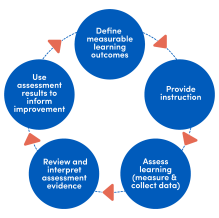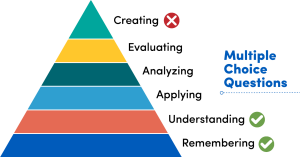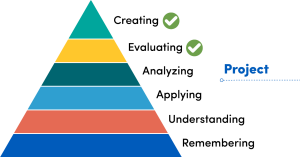Designing Assessments
Determining how and when students have reached course learning outcomes.
On this page:
Assessments in education measure student achievement. These may take the form traditional assessments such as exams, or quizzes, but may also be part of learning activities such as group projects or presentations.
While assessments may take many forms, they also are used for a variety of purposes. They may
- Guide instruction
- Determine if reteaching, remediating or enriching is needed
- Identify strengths and weaknesses
- Determine gaps in content knowledge or understanding
- Confirm students’ understanding of content
- Promote self-regulating strategies
- Determine if learning outcomes have been achieved
- Collect data to record and analyze
- Evaluate course and teaching effectiveness
While all aspects of course design are important, your choice of assessment Influences what your students will primarily focus on.
For example, if you assign students to watch videos but do not assess understanding or knowledge of the videos, students may be more likely to skip the task. If your exams only focus on memorizing content and not thinking critically, you will find that students are only memorizing material instead of spending time contemplating the meaning of the subject matter, regardless of whether you attempt to motivate them to think about the subject.
Overall, your choice of assessment will tell students what you value in your course. Assessment focuses students on what they need to achieve to succeed in the class, and if you want students to achieve the learning outcomes you have created, then your assessments need to align with them.
The Assessment Cycle
Assessment does not occur only at the end of units or courses. To adjust teaching and learning, assessment should occur regularly throughout the course. The following diagram is an example of how assessment might occur at several levels.
This cycle might occur:
- During a single lesson when students tell an instructor that they are having difficulty with a topic.
- At the unit level where a quiz or exam might inform whether additional material needs to be included in the next unit.
- At the course level where a final exam might indicate which units will need more instructional time the next time the course is taught.
In many of the above instances learning outcomes may not change, but assessment results will instead directly influence further instruction. For example, during a lecture a quick formative assessment such as a poll may make it clear that instruction was unclear, and further examples are needed.
There are several types of assessment to consider in your course which fit within the assessment cycle. The two main assessments used during a course are formative and summative assessment. It is easier to understand each by comparing them.
| Formative | Summative | |
|---|---|---|
| Assessment for Learning | Assessment of Learning | |
| Purpose | Improve learning | Measure attainment |
| When | While learning is in progress | End of learning |
| Focused on | Learning process and learning progress | Products of learning |
| Who | Collaborative | Instructor-directed |
| Use | Provide feedback and adjust lesson | Final evaluation |
An often-used quote that helps illustrate the difference between these purposes is:
“When the cook tastes the soup, that’s formative. When the guests taste the soup, that’s summative.” Robert E. Stake
Examples
| Formative | Both | Summative |
|---|---|---|
|
|
|
It is important to note, however, that assessments may often serve both purposes. For example, a low-stakes quiz may be used to inform students of their current progress, and an instructor may alter instruction to spend more time on a topic if student scores warrant it. Additionally, activities like research papers or presentations graded on a rubric contain both the learning activity as well as the assessment. If students complete sections or drafts of the paper and receive grades or feedback along the way, this activity also serves as a formative assessment for learning while serving as a summative assessment upon completion.
Used to determine student understanding and misconceptions before your course or unit begin to determine background knowledge on upcoming topics.
Used to determine whether students understood course content, as well as what instruction or active learning worked well. It can also determine misconceptions and questions students may still have. Formative assessments are used to inform further instruction.
Used to determine student learning at the end of the learning process. These forms of assessments usually result in a weighted grade.
A set of criteria used to evaluate student work that improves efficiency, accuracy and objectivity while simultaneously providing feedback.
Considerations
For assessments to accurately measure outcomes and to provide optimal feedback to students, the following should influence assessment choice and design:
Learning outcomes
- Cognitive complexity
- Options for expression
- Course and Class
Assessment and grading
- Weight of assessment
- Time for grading and feedback
- Delivery modes
Course level
- Prerequisites and post learning
- Class size
- Time and length of course
Students
- Practice opportunities
- Accessibility and accommodations
Provide Ongoing and Varied Methods
Because learning outcomes are unique, the types of knowledge and skills that demonstrate achievement of these outcomes will differ. Therefore, assessments will need to vary to capture this achievement. Consider using:
- Ongoing assessments: Regular assessment helps determine where students are on the learning continuum. These allow for
- Evaluation of participation and engagement
- Opportunities for feedback
- Demonstrable learner progress
- Opportunities to test and apply their knowledge
- Different types of evidence: The following resource summarizes the different types of evidence to determine progress and how this evidence can be collected.
Question Types
There are several types of questions that you can use to assess student achievement. The following links explain question types and how to design high-quality multiple-choice questions.
Overview of the different types of questions you can use for assessments.
Overview of how to access, add and use all the question types available in Brightspace to design an assessment.
Overview of how to construct high-quality multiple-choice test questions.
Alignment
At the beginning of choosing assessments for your course, you should start by reviewing the learning outcomes and then matching assessments to them. Assessments should align to the cognitive complexity (see Bloom’s Taxonomy) or type of learning (see Fink’s Taxonomy) of course learning outcomes.
For example, if your course outcomes expect students to be able to memorize or understand course content, exams with multiple choice questions may accurately assess these outcomes. If your outcome expects students to be able to create an original product, then a multiple choice question would not measure an innovative creation.
Instead, a project, graded with a rubric, may best assess this.
If an assessment does not map onto an outcome, you should ask whether you are missing a course learning outcome you care about and, if not, whether your assessment is necessary. Further, you may need to adapt the assessment itself or even your choice in assessment to align with the learning outcome.
The accompanying chart is helpful in choosing and reviewing your assessments as you create them. You may find as you go that a course outcome might change as you determine how you will be able to assess it or if the scope of the learning outcome is too large for the time needed for the assessment.
If you find most outcomes are assessed using quizzes and exams, consider alternative methods of assessment.
A colorized wheel illustrating how various assessments (60+) map onto the levels of learning outlined by Bloom.
Guide to developing formative assessment questions in alignment with Bloom’s Taxonomy.
- On your course design template, fill in the assessment column.
- Consider a variety of assessments (e.g., formative and summative assessments).
- Ensure assessments align to your course’s learning outcomes.
Now that you have chosen assessments to measure learning outcomes the next step is to consider methods of teaching.
If you would like to begin building some of your assessments, see:
The first step is deciding what you want your students to be able to do by the end of your course.
Examples for aligning assessments to the cognitive complexity of learning outcomes.


